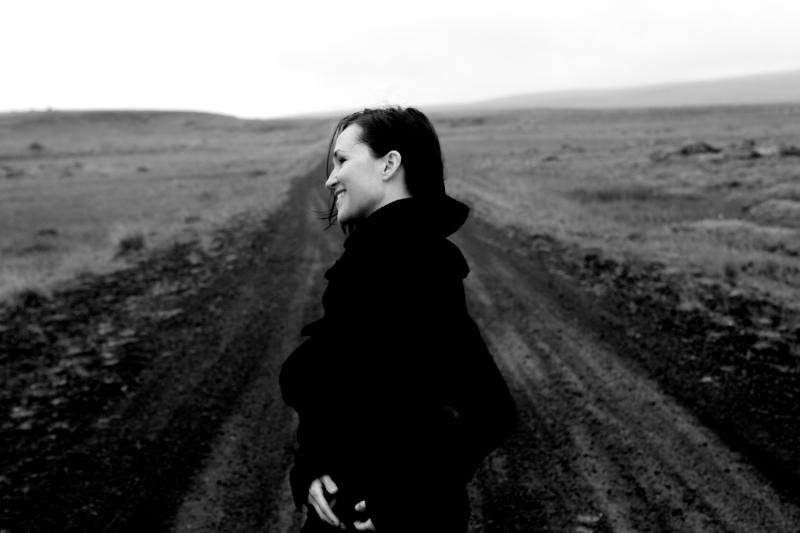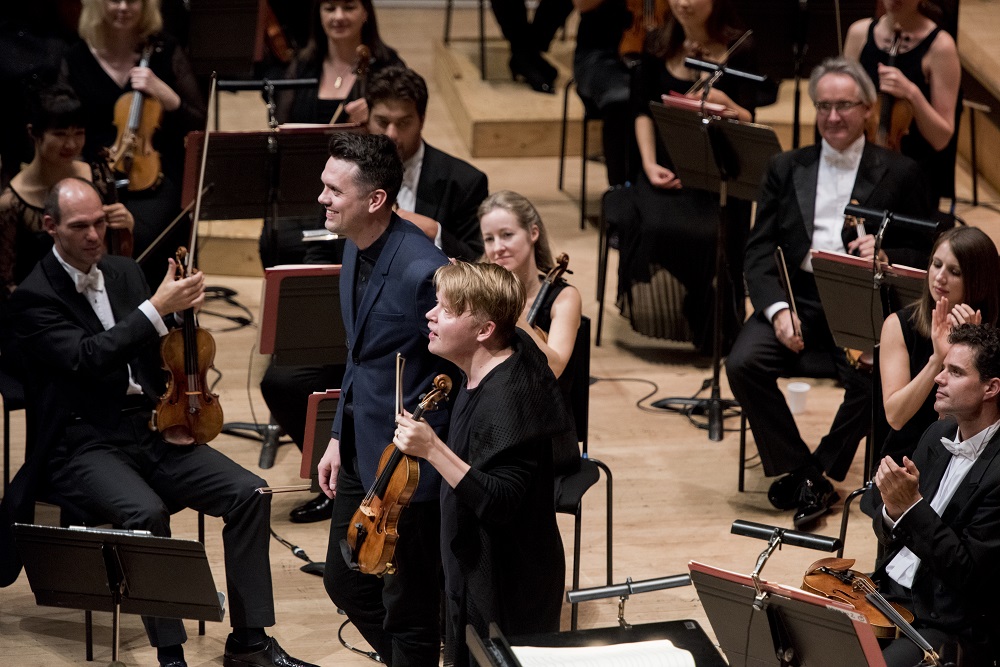Kuusisto, Philharmonia, Salonen, RFH review - Icelanders fare better than Sibelius | reviews, news & interviews
Kuusisto, Philharmonia, Salonen, RFH review - Icelanders fare better than Sibelius
Kuusisto, Philharmonia, Salonen, RFH review - Icelanders fare better than Sibelius
Frozen symphonies partly redeemed by animated violinist in an Icelandic concerto

London orchestras do communicate with each other, sometimes at least, when it comes to programming.
At least he didn’t make the mistake of lumping the two great but utterly different two last symphonies together like Rattle (another one who, it seems to me, just doesn’t get it). One day the enigmatic Sixth will find the place it deserves, at the end of a concert, where its final fade from sunset hymns into nothingness can truly be taken as one possible signing-off for Sibelius’s symphonic output (the fact that he went on to the Seventh, Tapiola and the far-from-incidental music to The Tempest only shows him capable of different possibilities in the art of the endgame). But it really didn’t make much difference given such a stolid approach to a work which should sing, fly, dart in and out of the forest, and leave us puzzled but bewitched.
This is music that needs to seem utterly organic. Slow-pacing the songs of thanksgiving that frame what should be a series of mysterious journeys takes them from the great outdoors and puts them in church. The Philharmonia played beautifully but coldly (with the exception of a serious woodwind-ensemble lapse just before the dying fall). There was more scope for grandeur in the Seventh, and Salonen at least knows how to negotiate its many tempo-changes. Its three peaks were well if obviously crowned by Michael Buchanan’s richly-upholstered trombone solo, but the scherzo-like passages around its central turbulence need respectively to needle fantastically and to make the heart leap in what sounds like a rustic idyll; these were both poker-faced and earthbound.

Two relatively young Icelandic composers fared much better than poor Sibelius. Aeriality by Anna Thorvaldsdóttir (strictly speaking, Þorvaldsdóttir) seemed at first to be once of those all-process, no-hooks soundworld pieces, textures discreetly seething with stock-in-trade quarter-tones around a series of unisons, but outlines of a real face emerged tantalisingly not long before the end. And yes, you could connect what you heard with the unique landscape of her homeland. Daníel Bjarnason’s Violin Concerto (the composer with Pekka Kuusisto pictured above last night by Camilla Greenwell), a rhythmic tour-de-force in total contrast, was obviously written for the idiosyncratic talent – close on genius – of Pekka Kuusisto (though you wouldn’t know it from a note which said absolutely nothing about the work itself).
Anyone who remembers Kuusisto’s whistling in spellbinding encores – the last I heard was a shatteringly moving Finnish lament in Kensington’s Cadogan Hall on the night of the Grenfell Tower fire – would identify with the concerto’s opening; there can’t be another like it. Tough, though, if as an orchestral player you can’t whistle too. The whole was too much a box of tricks catering for Kuusisto, though; with the generic dances going on at least five minutes too long, it didn’t seem sure of its direction, though the aerial conclusion, like the opening, was compelling. Best of all, as we’ve come to expect, was the encore this time, a melancholy Swedish wedding march with exquisite folk inflections. And Kuusisto (pictured below by Camilla Greenwell) went on to play more folk music in the Clore Ballroom afterwards, a postlude I’m sorry to have had to miss.

This was the official launch of the Nordic Music Days festival on the Southbank, offering plenty of new works and experimentations to follow over the weekend, but looking somewhat meagre on paper, the music itself swamped by peripheral events; anyway, give it a go. But if they thought they’d be setting the mood by calling in a lighting designer for the concert, they got it disastrously wrong. At first I thought the northern-lights effect was built into Thorvaldsdóttir’s piece: after all, the second hall in Reykjavík’s stunning Harpa arts centre might have given the cue in its lighting options. It was good to see the Festival Hall organ lit so beautifully as it had been for Jurowski’s LPO performance of Enescu’s Oedipe on Sunday. But there was no similar co-ordination in the changes here.
At one point there was a jarring switch to orange which had no precedent in the score, and the shifts throughout the Sibelius symphonies proved inept and distracting. You wanted to run backstage at the interval and ask them to stop it for the second half, which at least wasn’t quite so jarring. Money would have better spent on coaching the players to look involved. Kuusisto apart, this came across, both aurally and visually, as the launch not for a "Tender Is the North" festival – the Barbican’s title for much more substantial offerings – but for "Frozen Is the North", and a disappointment as a season opener after magnificent work from Rattle with the LSO, Jurowski and Oramo. Better is guaranteed to come shortly from the Philharmonia’s two great choices of principal guest conductors, Jakub Hrůša and Santtu-Matias Rouvali.
rating
Share this article
Add comment
The future of Arts Journalism
You can stop theartsdesk.com closing!
We urgently need financing to survive. Our fundraising drive has thus far raised £49,000 but we need to reach £100,000 or we will be forced to close. Please contribute here: https://gofund.me/c3f6033d
And if you can forward this information to anyone who might assist, we’d be grateful.

Subscribe to theartsdesk.com
Thank you for continuing to read our work on theartsdesk.com. For unlimited access to every article in its entirety, including our archive of more than 15,000 pieces, we're asking for £5 per month or £40 per year. We feel it's a very good deal, and hope you do too.
To take a subscription now simply click here.
And if you're looking for that extra gift for a friend or family member, why not treat them to a theartsdesk.com gift subscription?
more Classical music
 Bizet in 150th anniversary year: rich and rare French offerings from Palazzetto Bru Zane
Specialists in French romantic music unveil a treasure trove both live and on disc
Bizet in 150th anniversary year: rich and rare French offerings from Palazzetto Bru Zane
Specialists in French romantic music unveil a treasure trove both live and on disc
 Scottish Chamber Orchestra, Ibragimova, Queen’s Hall, Edinburgh review - rarities, novelties and drumrolls
A pity the SCO didn't pick a better showcase for a shining guest artist
Scottish Chamber Orchestra, Ibragimova, Queen’s Hall, Edinburgh review - rarities, novelties and drumrolls
A pity the SCO didn't pick a better showcase for a shining guest artist
 Kilsby, Parkes, Sinfonia of London, Wilson, Barbican review - string things zing and sing in expert hands
British masterpieces for strings plus other-worldly tenor and horn - and a muscular rarity
Kilsby, Parkes, Sinfonia of London, Wilson, Barbican review - string things zing and sing in expert hands
British masterpieces for strings plus other-worldly tenor and horn - and a muscular rarity
 From Historical to Hip-Hop, Classically Black Music Festival, Kings Place review - a cluster of impressive stars for the future
From quasi-Mozartian elegance to the gritty humour of a kitchen inspection
From Historical to Hip-Hop, Classically Black Music Festival, Kings Place review - a cluster of impressive stars for the future
From quasi-Mozartian elegance to the gritty humour of a kitchen inspection
 Shibe, LSO, Adès, Barbican review - gaudy and glorious new music alongside serene Sibelius
Adès’s passion makes persuasive case for the music he loves, both new and old
Shibe, LSO, Adès, Barbican review - gaudy and glorious new music alongside serene Sibelius
Adès’s passion makes persuasive case for the music he loves, both new and old
 Anja Mittermüller, Richard Fu, Wigmore Hall review - a glorious hall debut
The Austrian mezzo shines - at the age of 22
Anja Mittermüller, Richard Fu, Wigmore Hall review - a glorious hall debut
The Austrian mezzo shines - at the age of 22
 First Person: clarinettist Oliver Pashley on the new horizons of The Hermes Experiment's latest album
Compositions by members of this unusual quartet feature for the first time
First Person: clarinettist Oliver Pashley on the new horizons of The Hermes Experiment's latest album
Compositions by members of this unusual quartet feature for the first time
 Gesualdo Passione, Les Arts Florissants, Amala Dior Company, Barbican review - inspired collaboration excavates the music's humanity
At times it was like watching an anarchic religious procession
Gesualdo Passione, Les Arts Florissants, Amala Dior Company, Barbican review - inspired collaboration excavates the music's humanity
At times it was like watching an anarchic religious procession
 Classical CDs: Camels, concrete and cabaret
An influential American composer's 90th birthday box, plus British piano concertos and a father-and-son duo
Classical CDs: Camels, concrete and cabaret
An influential American composer's 90th birthday box, plus British piano concertos and a father-and-son duo
 Cockerham, Manchester Camerata, Sheen, Martin Harris Centre, Manchester review - re-enacting the dawn of modernism
Two UK premieres added to three miniatures from a seminal event of January 1914
Cockerham, Manchester Camerata, Sheen, Martin Harris Centre, Manchester review - re-enacting the dawn of modernism
Two UK premieres added to three miniatures from a seminal event of January 1914
 Kempf, Brno Philharmonic, Davies, Bridgewater Hall, Manchester review - European tradition meets American jazz
Bouncing Czechs enjoy their Gershwin and Brubeck alongside Janáček and Dvořák
Kempf, Brno Philharmonic, Davies, Bridgewater Hall, Manchester review - European tradition meets American jazz
Bouncing Czechs enjoy their Gershwin and Brubeck alongside Janáček and Dvořák
 Solomon, OAE, Butt, QEH review - daft Biblical whitewashing with great choruses
Even a top soprano and mezzo can’t make this Handel paean wholly convincing
Solomon, OAE, Butt, QEH review - daft Biblical whitewashing with great choruses
Even a top soprano and mezzo can’t make this Handel paean wholly convincing

Comments
This review borders on being
That's not the sort of
That's not the sort of comment that is usually acceptable, Bill. I can assure you I am nowhere near clinical depression, a subject about which I know and which I would advise you not to make light of. Nor was my concert-going companion, a very vivacious person who felt exactly the same as I did.
Aeriality was a fabulous
I agree that atmospheric
I agree that atmospheric lighting is welcome, especially on the Festival Hall organ - as I suggested, I admired it to begin with. But the changes which bore no relation to the music were simply a distraction - one kept wondering why and how the players felt about them. As for the playing, it was wonderful in an objective sense. I simply neither saw nor felt the impetus behind it.
Not a comment on these
Thank you, John. I 'did' a
Thank you, John. I 'did' a BBC Radio 3 Building a Library on Sibelius Six a couple of years ago and the clear front-runner for me was Neeme Järvi's first recording with the Gothenburg Symphony Orchestra (also on BIS). Kamu's Lahti recording came after that, of course, and I certainly felt their performance in Lahti was the best I've head live.